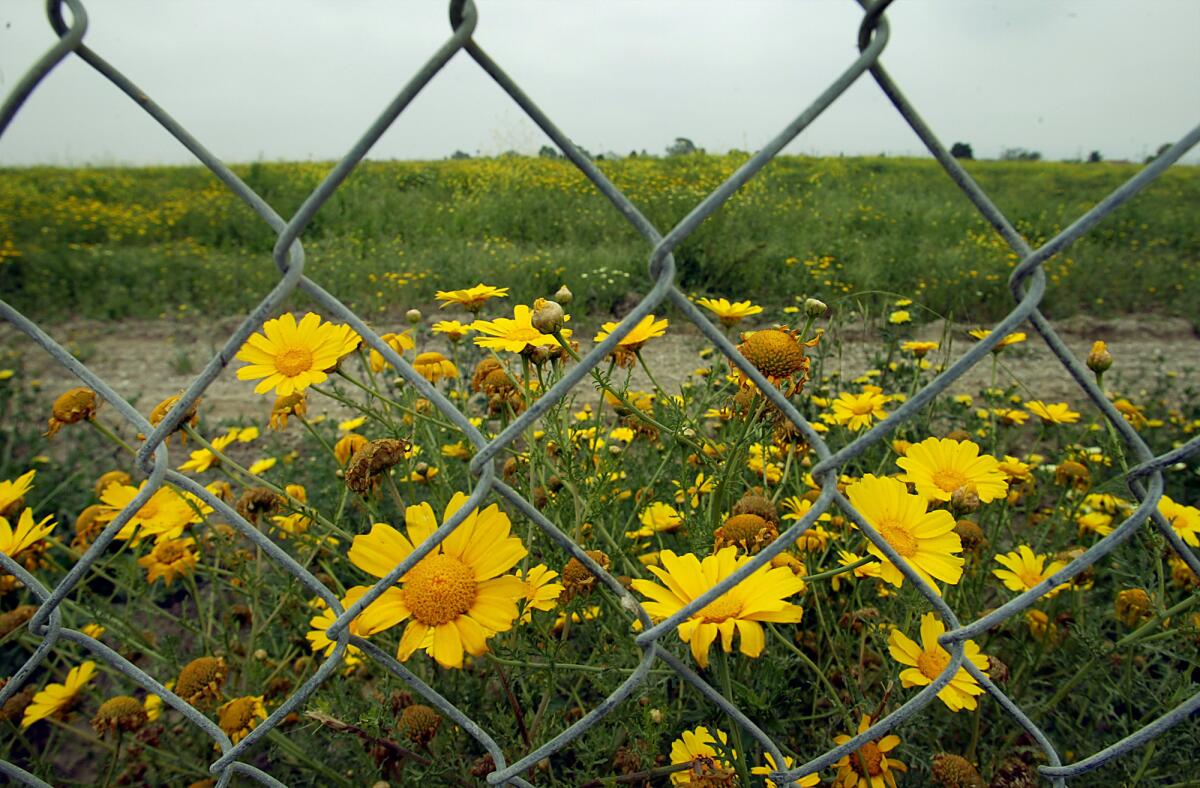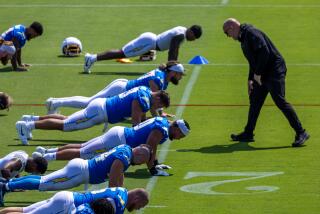From the archives:: 2003 Carson plan: Stadium site has been a tough sell

The site for a stadium that could bring professional football back to the Los Angeles area is 157 acres of moldering garbage and toxic waste, a fenced-off field of weeds that leaks methane, spooks investors and attracts legal trouble.
The parcel is the old Cal Compact Inc. landfill in Carson. Its story is a tangled, four-decade tale of polluted air and poisoned groundwater and failed plans for shopping malls and mobile home parks. And bankruptcies, lawsuits and criminal cases that include the current fraud prosecution of a former labor union pension administrator.
Among the chief promoters of the landfill’s gridiron potential are a fallen Hollywood deal-maker, Michael Ovitz, and Carson Mayor Daryl Sweeney, who is awaiting trial on unrelated bribery charges.
But the property is no dump to the National Football League. For the second time in five years, the league is sizing up the wedge of real estate as the would-be address of an NFL franchise, a competitor in the stadium sweepstakes with the Rose Bowl and the Los Angeles Memorial Coliseum.
“A number of extraordinary and unusual things have occurred with this property over the years,” said Mitchel Whitehead, an attorney for the glaziers union pension fund, which owns the landfill and has been trying to unload it for years. “I cannot overstate the complexity.... It takes 10 to 50 pages of briefings just to describe the background.”
Even so, it is one of the roomiest vacant lots in the Los Angeles Basin, and its location near the junction of the San Diego and Harbor freeways is prized.
Last week, the NFL authorized Commissioner Paul Tagliabue to take a $10-million option on the land. Its value is thought to be about $25 million, according to participants in the stadium talks. Over the years, appraisals have fallen as low as zero at the height of the property’s pollution troubles.
The NFL has yet to hand off the option dollars, and the league still could turn up its nose at the waste yard -- just as it did in 1999, when Houston eventually won the bidding for a stadium. “We’re quite a ways from having any deal in place,” said NFL spokesman Greg Aiello.
Much Has Changed
And much has changed since the NFL’s previous pass at Carson.
A web of legal disputes over the property -- involving soured investments, ownership stakes and cleanup liabilities -- has been cleared away. A civil case that gave the union pension fund sole title to the landfill, however, might be appealed to the U.S. Supreme Court.
On the contamination front, industrial solvents, heavy metals, arsenic and pesticides are being contained or removed under state supervision, although slowly.
Methane leaks are regularly plugged with earth, and extraction wells soon will be installed to vacuum out the gas, said Thomas Cota, who heads the local branch of the state Toxic Substances Control Department.
But the major work remains to be done -- at a cost of $26 million to $35 million, according to state officials and others.
Some cleanup money has come from BKK Corp. -- a successor to Cal Compact -- from the pension fund and from the oil companies that trucked drilling mud and fluids to the landfill, which closed in the 1960s. Any buyer would assume the remaining tab, officials said.
Until then, L.A. MetroMall, the pension-owned firm that holds title, is responsible for the detox job, according to a 1997 federal consent decree. That agreement resulted from a state lawsuit against the firm to require the cleanup.
The pension fund, for its part, sued the oil companies. In a settlement, the firms agreed to payments totaling $10 million. And they, in turn, have sued more than two dozen cities that dumped trash in the landfill, including Los Angeles and Long Beach, in hopes of recouping the money.
Deputy state Atty. Gen. Dennis Ragen said a settlement in that case is expected soon.
Once the cleanup is done, millions more would have to be spent to shore up the spongy terrain for construction. A clay or synthetic “cap” would be placed over the soil to trap pollutants, and pylons would be driven 50 or 60 feet into the ground to support a stadium.
Retail Center Proposed
Last year, GMS Realty of Carlsbad made an offer on the landfill, with designs for a 1.3-million-square-foot retail center. GMS executives are now huddled with the pension fund’s trustees to acquire the property for resale to the NFL.
The GMS venture follows a series of aborted efforts to anchor stores, restaurants and movie theaters atop the landfill, whenever a football stadium wasn’t on the table. Carson officials touted the site as a base for the Los Angeles Rams in 1978 and the Los Angeles Raiders in 1987.
Other dead-on-arrival proposals called for mobile homes, condominiums and a hotel tower. Many were thwarted by the environmental and legal problems.
The lumpy, wildflower-dusted plot runs along East Del Amo Boulevard, across from the Dominguez Golf Course and hard by the San Diego Freeway. Mobile home parks crowd its boundaries off Main Street and Avalon Boulevard.
A few empty roads cross the landfill. The city also has erected a bridge on Del Amo that vaults the freeway and the Dominguez Channel, connecting the property to the South Bay Pavilion shopping mall.
Just north of the mall is Cal State Dominguez Hills. On Sunday, a 27,000-seat stadium for the Galaxy soccer team will open at the campus, along with a tennis arena and an Olympic training academy.
The privately built stadium, called the Home Depot Center, also will be the summer camp of the San Diego Chargers, one of several NFL franchises said to be considering a move to the area.
In Redevelopment Zone
Backers of a Carson football stadium see it as the perfect complement to the Home Depot Center. They also note that the landfill is within a city redevelopment zone, which could qualify a stadium builder for millions of dollars in taxpayer subsidies.
In 1999, the Carson City Council appeared ready to funnel $180 million in redevelopment funds to a stadium. It viewed an NFL venue as the capstone of a decades-long labor to lift Carson, population 90,000, above its roots as a sooty industrial town.
This time around, however, the council might not be so generous. The feeling at City Hall is that football needs Carson as much as Carson needs a stadium. “It has to work for us,” said City Manager Jerry Groomes.
But he did not hide his enthusiasm. The stadium “is a real opportunity,” Groomes said. “People from all over L.A. and Southern California will know Carson.”
Lately, Carson has been known for a blitz by federal investigators, inside City Hall and out.
A former administrator for the Glaziers, Architectural Metal & Glass Workers’ pension fund, which began investing in the landfill in 1989, has been indicted on charges of defrauding the union’s retirees.
William Seay is accused of overstating the value of the parcel and concealing his ownership interest in an adjoining 14 acres.
From 1995 to 1997, he allegedly sought to enrich himself by persuading the pension fund to increase its investment -- to $33 million -- despite the looming cleanup and engineering expenses.
Seay has pleaded not guilty and faces a September trial. His case has no direct bearing on the NFL negotiations.
Two would-be developers of the landfill also have spent a lot of time in court. In July, Robert Ferrante will be sentenced for his role in a kickback scheme that defrauded the pension fund in a case that involved a San Diego-area housing project.
Ferrante was poised to become a partner in a mall at the flashy stadium-and-retail plaza that Ovitz pitched to the NFL in 1998 and ’99. An Irvine savings and loan company that Ferrante owned went bankrupt in the 1980s, in part because of bad loans linked to the Cal Compact property. He and an associate, Peter Sardagna, were acquitted of federal criminal charges in the savings and loan collapse.
Sardagna claimed a 1% stake in the landfill. The pension fund successfully sued to have him scratched from the title. Last week, the U.S. 9th Circuit Court of Appeals upheld that verdict, but Sardagna’s lawyer said the battle is not over. “We’ll probably file a petition with the Supreme Court,” Hillel Chodos said.
Meanwhile, Ovitz’s long run of setbacks has continued since his earlier dalliance with the NFL.
The co-founder of Hollywood’s powerful Creative Artists Agency, he launched another talent firm, which crashed last year. He had left Creative Artists Agency to become president of Walt Disney Co. in 1995, but was ousted 14 months later.
His precise role in the Carson deal is unclear. Ovitz, who did not respond to requests for comment, has no ownership in the property or formal relationship with the NFL. Offering himself as a sort of go-between, he contacted GMS, the real estate firm, to urge it to listen to the NFL before committing to a mall at the landfill, said company President William Gerrity, the top player in the negotiations between the league and the pension fund.
“He’s been a great guy to work with,” said Gerrity, who suggested that Ovitz could become a partner in the development.
Scandals Downplayed
Gerrity and NFL spokesman Aiello said the scandals plaguing Carson -- particularly Mayor Sweeney’s indictment -- should not be a factor. “All we can do is take it one step at a time,” Gerrity said.
Sweeney sits on the five-member City Council that must approve a stadium plan. He is to go on trial in July on charges that he solicited bribes from trash haulers who were seeking city contracts. He has pleaded not guilty.
Several other former elected officials have pleaded guilty to corruption and tax offenses.
Assistant U.S. Atty. John Hueston said federal agents are not through poking through City Hall transactions. He did not elaborate.
Sweeney still reports for work, and appears to be the point man for the stadium. But the indictment has weakened his position on the council, which seems split on the stadium.
“I’m skeptical,” said Councilman Jim Dear, who suspects the NFL could be using the landfill as a bargaining chip for the Rose Bowl or Coliseum. “Are they just using Carson as leverage for someplace else?”
Dear said Sweeney’s pending trial complicates things. But the mayor emphasized that his indictment has “nothing to do with football.”
He hopes to quarterback the campaign to put Carson on the NFL map. In 1999, he was the city’s lead cheerleader to convert the landfill into a stadium.
“I’ve been down this road before,” Sweeney said. “It’s been a tough property.”
More to Read
Sign up for Essential California
The most important California stories and recommendations in your inbox every morning.
You may occasionally receive promotional content from the Los Angeles Times.











